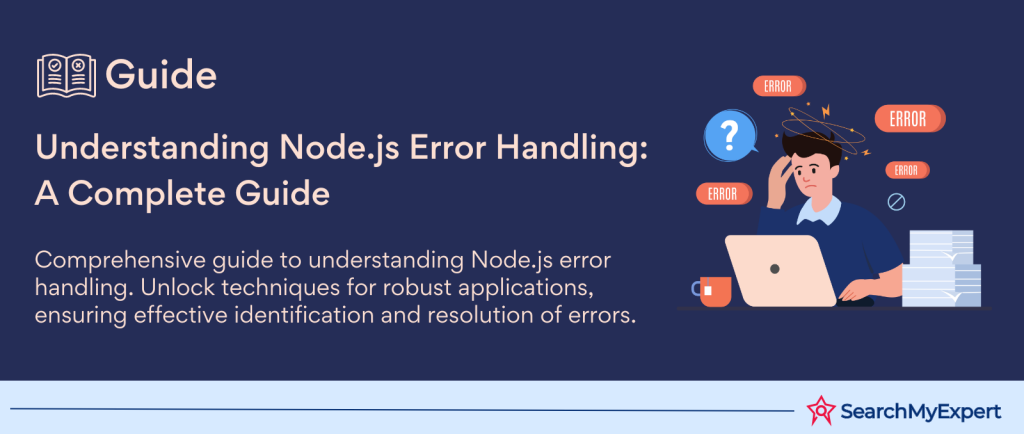Understanding Errors in Node.js
In the world of software development, particularly within the Node.js ecosystem, understanding and effectively managing errors is not just a necessity but an art. Errors in Node.js can broadly be categorized into two main types: Operational Errors and Programmer Errors. Grasping the nuances of these errors is crucial for crafting resilient applications that offer seamless user experiences. This article delves into the intricacies of these error types, emphasizing the importance of robust error-handling strategies for maintaining application stability and ensuring a positive user experience.
Operational Errors: The Unavoidable Hurdles
Operational errors are essentially the runtime problems encountered by correctly-written programs. These are not bugs in the code but rather issues with the system’s operation, such as:
- Failed network requests:
Occurs when a request to a remote server times out or is unreachable. - Resource unavailability:
This happens when a required file is missing or a database is inaccessible. - Permission issues:
Arise when the Node.js process does not have sufficient permissions to perform a certain action.
Handling these errors is vital as they are expected to occur under normal operating conditions. The goal here is not to eliminate these errors but to anticipate and manage them gracefully, ensuring the application remains robust and reliable.
Programmer Errors: The Bugs to Squash
On the flip side, programmer errors are bugs in the code that need to be identified and corrected. These include:
- Syntax errors:
Caused by typos or mistakes in the code that prevent the program from running. - Type errors: Occur when an operation is performed on an incorrect data type.
- Logic errors: Result from flawed logic that leads to incorrect behavior or results.
Unlike operational errors, programmer errors are preventable and should be resolved during the development and testing phases. Effective debugging tools and practices are indispensable for identifying and fixing these issues.
The Imperative of Error Handling
Error handling in Node.js is not just about preventing the application from crashing; it’s about ensuring continuity of service, safeguarding data integrity, and delivering a user experience that is as uninterrupted as possible. Here are a few reasons why error handling is paramount:
- Stability:
Proper error handling prevents uncaught exceptions from terminating the Node.js process, thus maintaining the application’s stability. - Security:
By managing errors correctly, sensitive information is less likely to be inadvertently leaked, enhancing the application’s security posture. - User Experience:
Thoughtfully responding to errors can help provide informative feedback to users, reducing frustration and increasing satisfaction.
Core Error Handling Mechanisms in Node.js
Effective error management is a cornerstone of resilient Node.js applications. Developers have several tools at their disposal for handling errors, each suited to different scenarios and codebases. Understanding these mechanisms—Try-Catch Blocks, Callbacks, Promises with then/catch blocks, and Async/Await syntax—is key to developing robust applications.
Try-Catch Blocks for Synchronous Code
The try-catch mechanism is the foundation of error handling in synchronous JavaScript operations. This approach allows you to execute a block of code and catch any errors that may arise during its execution. The syntax involves two main parts: the “try” section, where the potentially error-throwing code is placed, and the “catch” section, where you define how to respond to those errors. This mechanism is particularly useful for operations that might fail due to reasons beyond the code’s control, such as parsing JSON from an external source or accessing a resource that may not be available.
Callbacks in Asynchronous Functions
Node.js’s asynchronous nature often involves callback functions, which can also serve as a means for error handling. The conventional pattern in Node.js for callbacks is the Error-First Callback, where the first parameter is reserved for an error object, and the subsequent parameters are for successful response data. This pattern is fundamental for Node.js developers, especially when dealing with Node’s core modules like filesystem operations or network requests.
Promises and Then/Catch Blocks
With the introduction of Promises to JavaScript, error handling for asynchronous operations has become more intuitive. A Promise represents a future value, either a successful response or an error. The then method is used to handle a promise’s successful resolution, while the catch method is dedicated to handling errors. This separation makes the code more readable and easier to maintain, especially for complex asynchronous operations that might involve chaining multiple promises.
Advanced Error Handling Techniques in Node.js
As Node.js applications grow in complexity, developers seek more sophisticated error-handling techniques to maintain code readability, ensure application stability, and provide a better user experience. Advanced error-handling strategies such as Custom Error Classes, Error Middleware in Express-like frameworks, and Global Error Handlers play a crucial role in achieving these goals. These techniques not only help in managing errors more efficiently but also in creating a more maintainable and scalable application architecture.
Custom Error Classes for Specific Error Types
Creating custom error classes in Node.js is a powerful technique for handling specific error types more effectively. By extending the built-in Error class, developers can create distinct error types for different parts of their application, such as authentication errors, validation errors, or database errors. This approach enables more granular error handling and allows for clearer, more meaningful error messages. Custom error classes can also carry additional information pertinent to the error, making debugging and error reporting more insightful.
Error Middleware in Express-like Frameworks
Frameworks like Express provide a middleware layer that can be leveraged for centralized error handling. Error middleware functions are defined with four arguments instead of the usual three, explicitly signaling to Express that they are meant to handle errors. These functions catch errors from preceding middleware and routes, providing a centralized place to manage error logging, send error responses to the client, or even trigger recovery mechanisms. This pattern is particularly useful for API development, where consistent error responses are crucial for client-side error handling.
Logging and Error Reporting in Node.js
Effective logging and error reporting are critical components of a comprehensive error-handling strategy in Node.js applications. These practices not only aid in debugging and analysis but also play a pivotal role in monitoring application health and detecting issues before they impact users. By choosing the right logging library and integrating error reporting with developer dashboards or monitoring tools, developers can significantly enhance their ability to maintain and improve their applications.
Logging Errors for Debugging and Analysis
Logging is the process of recording application events, which can range from general information and debug messages to warnings and errors. Effective error logging provides insights into the application’s behavior under various conditions, helping developers identify, diagnose, and fix issues more efficiently. When logging errors, it’s important to include as much context as possible, such as the error message, stack trace, timestamp, and any relevant user or request data. This context is invaluable for debugging and can help pinpoint the root cause of issues more quickly.
Choosing the Right Logging Library
The Node.js ecosystem offers a wide range of logging libraries, each with its own set of features and configurations. Some popular options include:
- Winston:
A versatile logging library that supports multiple transports (e.g., console, file, remote services) and configurable log levels. - Bunyan: Focuses on JSON logging, making logs easily consumable by external systems and services.
- Pino:
Known for its performance and low overhead, Pino is a great choice for high-throughput applications.
Sending Error Reports to Developer Dashboards or Monitoring Tools
Beyond local logging, forwarding error reports to external dashboards or monitoring tools can provide deeper insights and proactive alerting. Tools such as Sentry, LogRocket, and Datadog specialize in aggregating, analyzing, and alerting on errors in real time. Integrating these tools into your Node.js application allows you to:
- Monitor application health:
Get an overview of error rates, affected users, and system performance. - Analyze errors in detail:
Dive into individual error occurrences to understand their impact and root causes. - Receive alerts:
Set up real-time notifications for critical errors or unusual activity, enabling rapid response to issues.
Best Practices for Effective Error Handling in Node.js
Effective error handling is a hallmark of robust, reliable Node.js applications. It not only aids in troubleshooting but also enhances the user experience by ensuring the application can handle errors gracefully. Adhering to best practices in error handling can dramatically improve the resilience and usability of your applications. Here, we explore key strategies such as providing informative error messages, specific error handling and ensuring graceful failure, all of which contribute to a more stable and user-friendly application.
Informative Error Messages
The cornerstone of effective error handling is the provision of informative, clear, and actionable error messages. Errors should convey enough information to help developers understand the context and root cause of the issue without exposing sensitive application details that could pose security risks. This involves:
- Descriptive messages:
Error messages should describe what went wrong and, if possible, why. For instance, instead of a generic “Error occurred,” specify “Failed to connect to the database.” - Consistent format: Adopt a consistent format for error messages, making them easier to read and parse, both for developers and logging tools.
- User-friendly responses:
When errors impact users directly, provide non-technical messages and guide them on what to do next, enhancing the overall user experience.
Specific Error Handling
Treating all errors the same is a common pitfall. Different errors require different handling strategies; for example, a validation error needs a different approach than a database connection error. Specific error handling involves:
- Classifying errors:
Utilize custom error classes or error codes to categorize errors based on their type and severity. - Tailored responses:
Implement error-specific logic that could range from retrying a failed operation, rolling back transactions, or providing alternate content to the user. - Logging details: Log technical details about the error internally while presenting a generic, user-friendly message to the end-user.
Graceful Failure
Applications should anticipate errors and handle them in a way that minimizes disruption to the user experience. Graceful failure is about failing without crashing the application and providing alternatives or recovery options when possible. This includes:
- Fallback mechanisms: Implement fallbacks for non-critical features, ensuring that the core functionality of your application remains operational even when secondary features fail.
- Transaction integrity: In operations involving multiple steps or resources, ensure that failure at any stage does not leave the system in an inconsistent state. Use transactional operations or implement compensation logic to revert changes.
- User guidance: Inform users of what went wrong and provide options to recover from the error, such as retrying the operation, contacting support, or navigating to other sections of the application.
Testing Error Handling in Node.js Applications
Ensuring that your Node.js applications can gracefully handle errors is pivotal to maintaining stability and providing a seamless user experience. To achieve this, thorough testing of error-handling logic through both unit and end-to-end tests is essential. This approach helps in identifying and rectifying potential issues before they affect the end-users.
Writing Unit Tests for Error Handling Scenarios
Unit testing focuses on individual components or functions, making it ideal for testing error-handling logic in isolation. Here’s how you can approach this:
- Identify Error Scenarios:
Begin by identifying various error conditions your code might encounter. This could include invalid input, failed external API calls, or any situation that would throw an error. - Simulate Errors:
Use mocking tools to simulate errors in dependencies or external services. This helps in testing how your code responds to various error conditions without having to rely on actual external failures. - Assert Error Handling:
Ensure your tests check that the correct errors are thrown, and the expected error handling behavior is performed. This might include logging errors, cleaning up resources, or returning specific error responses. - Validate Error Messages and Types:
Check that the errors have meaningful messages and the correct types. This is crucial for debugging and for ensuring that downstream code can handle the errors appropriately.
Using End-to-End Tests to Simulate User Interactions and Error Cases
End-to-end (E2E) testing simulates real-world user scenarios, covering the full stack of the application. This type of testing is key to ensuring that the application behaves as expected in the face of errors during actual use.
- Design Realistic Scenarios:
Craft test cases that mimic user behavior leading to error conditions. This could involve simulating network failures, interacting with the UI in ways that trigger backend errors, or testing the application’s response to corrupt data. - Automate User Interactions: Utilize E2E testing frameworks like Cypress, Selenium, or Puppeteer to automate browser actions. This includes navigating through the application, filling out forms, clicking buttons, and verifying that the application responds correctly to errors.
- Check User Feedback:
It’s crucial to verify that the application provides appropriate feedback to the user in error situations. This includes displaying error messages, redirecting users to an error page, or offering alternatives to recover from the error. - Evaluate Fallback Mechanisms: Test the effectiveness of any fallback mechanisms or features designed to maintain functionality when errors occur. Ensure that these mechanisms activate as expected and provide a path forward for the user.
Resources on Error Handling in Node.js
Robust error handling is the backbone of production-ready applications, ensuring they are resilient, reliable, and user-friendly. In the dynamic environment of Node.js, where asynchronous operations and network interactions are commonplace, mastering error handling is essential. It not only aids in preventing application crashes and data corruption but also significantly enhances the user experience by providing meaningful feedback and seamless recovery options.
The journey to effective error handling in Node.js encompasses understanding different types of errors, employing core mechanisms like try-catch blocks and promises, leveraging advanced techniques such as custom error classes and middleware, and thoroughly testing error handling logic. By adhering to best practices and continuously refining error-handling strategies, developers can craft applications that stand the test of real-world usage and user expectations.
Further Resources for Learning and Diving Deeper
To further your understanding and mastery of error handling in Node.js, here are some invaluable resources:
- Node.js Documentation: Start with the official Node.js documentation for an overview of error handling capabilities and guidelines provided by Node.js itself. Visit Node.js Documentation.
- Express.js Guide on Error Handling:
For those using Express.js, the framework’s official guide on error handling offers insights into middleware and best practices specific to Express applications. Explore Express.js Error Handling. - MDN Web Docs on JavaScript Error Handling:
The MDN Web Docs provide a comprehensive look at error handling in JavaScript, offering a solid foundation that applies to Node.js development as well. Learn from MDN Web Docs. - Async/Await in JavaScript:
Understanding async/await syntax is crucial for modern Node.js applications. This resource offers a deep dive into using async/await for error handling. Deep Dive into Async/Await. - Books and Online Courses:
Look for books and online courses on Node.js that cover error handling extensively. Platforms like Udemy, Coursera, and Pluralsight offer courses tailored to both beginners and advanced developers. - Community and Forums: Engage with the Node.js community through forums like Stack Overflow, Reddit, and the Node.js Foundation’s community channels. Real-world problems and solutions discussed here can provide practical insights and innovative approaches to error handling.
Conclusion:
Error handling is an indispensable aspect of developing resilient and efficient Node.js applications. This guide has journeyed through the essentials of distinguishing between operational and programmer errors, implementing core error handling mechanisms, and leveraging advanced strategies to ensure robustness and reliability. We’ve underscored the importance of informative error messages, specific error handling, graceful failure strategies, and the critical role of thorough testing in maintaining application integrity.
Build scalable network applications with Node JS Development Service Companies.
Table of Contents
Toggle






